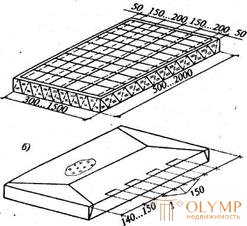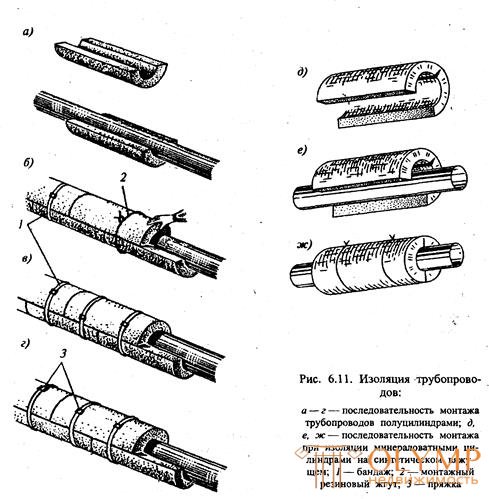
Precast block insulation consists of separate factory-made elements - slabs, tiles, shells, segments.
Thermal insulation of structures (walls, ceilings) and pipelines consists of heat insulation, vapor barrier (for surfaces with negative temperatures) and coating layers, as well as reinforcing and fasteners.
Mineral wool is widely used as heat insulation . This is due to the high thermal insulation characteristics of the material and products made from it, non-deficiency, low cost of raw materials, a wide range of products manufactured by the industry - plates, bags, pierced mats, half-cylinders, products with corrugated structure and others. a layer of compacted mineral wool of uniform thickness and wrapped
Fig. 20.5. Package mineral wool flashing: a-in a metal grid; b-dense facing | wrapped in package form. Packages are intended for thermal insulation of structures and pipelines at the temperature of the insulated surface from - 180 to +600 ° С. Glass fiber mats are rectangular elastic plates made from several superimposed layers of continuous fiberglass, coated with two hundred |
Heat-insulating plastics - polymeric foam materials with low density and high thermal insulation properties - have gained widespread use in construction. They are made of synthetic polymers (polystyrene, phenol-formaldehyde, urea-formaldehyde, polyvinyl chloride). Ease and porosity (up to 95%) is achieved by introducing a gaseous substance into the liquid polymer composition.
Plastics are used in the form of plates and foams to isolate flat surfaces and surfaces with a large radius of curvature. Plastic materials are an effective insulation for building envelopes and for insulation of refrigerators.
Insulating surfaces with mineral wool and fiberglass mats and slabs includes the following processes as the main ones: installation of products on pins or wire ties; bending the pins or bandaging the ties; sealing of seams with waste; stitching joints and additional fastening of mats with strings, rings and bands. When installing the product, they should be tightly fitted to each other, which is ensured by fastening the insulating elements with pins on which they are pinned (fig. 6.6). Pins bend flush with the outer surface of the insulation.
Places of loose contact between the insulation boards must be sealed with scrap and waste. Plates and mats with protective sheaths must be stitched with wire. Insulation to the surface can also be attached with wire ties (Fig. 6.7). The distance between the fastening pins and wire ties depends on the nature of the insulated surface. When the temperature of the insulated surface is up to + 300 ° С, the pins are located at a distance of 500 mm from each other, and at a temperature above +300 ° С - after 250 mm
Insulation of vertical steel tanks with panel prefabricated structures is performed sequentially. First, panels of aluminum sheet are installed on the cylindrical walls of the tank, on the inner side of which there is a heater (mineral wool piercing mat with a metal grid). Installation of the panels begin in vertical rows from the bottom up (Fig. 6.8, 6.9). From each parking of the mounting mechanism, the panels are installed to the full height in 2 ... 4 adjacent vertical rows; the work is done using mechanized scaffolding and lifting.
| Fig. 20.6. Fencing designs for refrigerators: a - brick wall; 6 - wall of lightweight aggregate panels; in-reinforced concrete girder coating; g- reinforced concrete surface of ribbed slabs; d- paved coating; e- walls of three-layer panels with metal lining and difficult to burn insulant; 1- Cyrpichnaya masonry; 2- plaster or plasterboard sheets; 3- vapor solution layer; 4- heat insulation layer; 5- claydite-thin panel; 6-roof deck with a protective layer; 7-reinforced concrete screed; 8-gel concrete slab, δ = 160 mm; 9 - the same, δ = 30 mm; 10 metal cladding |
The roofs of the tank are insulated with pierced mineral wool mats and then coated with sheet aluminum or galvanized steel with a layer of 0.8 ... 1 mm. The installation of heat-insulating roof structures starts from the edge to the center and is carried out with fully completed sectors.
Thermal insulation of structures subjected to vibration and shock should not be made of mineral wool and backfill materials. In separate workshops and rooms there should be no pollution of the surrounding air from the heat-insulating materials used. The use of products made of mineral wool or fiberglass is allowed only when they are fenced on all sides with a silica or glass cloth under a metal coating layer.
Isolation of building structures of refrigerators is performed
in the presence of a roof or a reliable cover to eliminate the possibility of moisture insulation of atmospheric precipitation. Thermal insulation of the enclosing surfaces is carried out mainly by mineral wool plates on bitumen binder and polystyrene foam plates, which are installed locally. Found and use of prefabricated panels of these materials (Fig. 20.6 -6.11).
The industry produces semi-cylinders polystyrene, designed to isolate pipelines with a diameter of 25 ... 219 mm with a temperature of the insulated surface from - 190 to +80 ° C. Sizes of products, mm: length 1000, thickness 30 ... 85 (with an interval of 5 mm).
Pipeline insulation with semicylinders and mineral wool cylinders is performed on a synthetic binder (Fig. 20.7. 6.11). Semi-cylinders and cylinders are installed with a fit in place with the seal of the seams and secured with bandages. Bandages are used from steel tape or wire. Products are fixed on the pipeline on a synthetic binder with offset transverse seams.
For duct laying of pipelines, protective coatings are made of fiberglass or foam plastic. The insulating layer on the pipelines is applied in the factory (Fig. 20.8).
The production of industrial thermal insulation structures for thermal insulation of pipelines was mastered. Constructions weighing up to 20 kg are manufactured in the form of cylinders with one cut along a generator or from two half-cylinders. The complete structures are a set selected by the size of the insulated pipeline, including the main heat insulation layer, the protective coating and the necessary fasteners (fig. 20.9).


Fig. 20.8. Pipeline block with foam insulation
Thermal insulation of plates, panels and blocks is laid on horizontal surfaces dry with seals, on vertical surfaces the insulation is carried out in the form of masonry walls with dressing on cement-sand mortar. Specific features of the technology of thermal insulation devices should be specified in the project.
The shells and segments used in the insulation of pipelines. They are laid dry on an insulated surface, tightly fit to each other. If necessary, the external seams are filled with mastic, and the segments are fixed on both sides with wire rings or bandages made of strip iron or aluminum. To speed up work on the pipeline, they initially put on a rubber mounting ring, under which
but)
| Fig. 20.9. Thermal insulation structures for pipe insulation: I — full-assembly: a — assembled; 6 - disassembled; 1 - metal insulating layer; 2 - coating metal layer; 3 - bandages; 4 - cover layer; c - insulation installation process; g - mounted design; II — complete: a — c — completion of installation (tightening the coating and installing self-tapping screws); III-universal: a-block; 6-packaged; 1-metallic coating; 2-liner with corrugated structure; 3 pin; 4- fastener; 5 piercing tongs |
| Fig.20.10. Metallic coating of pipelines from a smooth sheet |
Fig. 20.11. Pipe insulation by semicylinders (a) and segments (b):
1- half cylinder (segment); 2- banding metal tape; 3 - tension key; 4-strand; 5- pipeline; 6- rubber cord; 7- bandages (rings) of wire
slip through the segments. As they are assembled, the insulation is pulled off with wire rings, and the mounting ring is moved to a new position (fig. 20.11).
For finished insulation, a layer of protective plaster is arranged or covered with a layer of aluminum foil.
The device insulation in winter conditions. Thermal insulation in winter is carried out in conditions that exclude the wetting of the insulated surface and the insulating material, the performance of work during rain or snowfall should be excluded. Heat insulation is applied to the surface, cleared of snow and ice, well prepared and covered with waterproofing. Mastic and molded heat insulation is applied only on the warmed surface, they are performed in teplyak at a temperature not lower than 5 ° С. For the device enveloping and piece waterproofing requires a surface with a positive temperature and no precipitation. It is not recommended to perform work at temperatures below - 20 ° C.
Что бы оставить комментарий войдите
Комментарии (0)